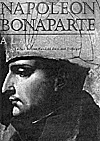 Author: Alan Schom
Author: Alan Schom
Pages: 888
Illustrations: 86 black and white period illustrations; 45 of "Bonaparte's, Relatives, and Friends" and 41 of "Opponents", "Battles and Other Events", and "Places".
Maps: 20; 12 strategic showing Europe in 1806 and 1789/1814 and theaters of operation noting locations of battles, plus 8 tactical, only one of which (Aboukir Bay) shows actual unit positions and movements -- the rest are very sparse, with few terrain features and no unit positions (Waterloo simply shows the villages and roads with the words "Wellington" at the top and "Napoleon" at the bottom).
Footnotes: 1,592
Appendices: 2, a list of Napoleon's 26 marshals and an incredibly revealing "Medical Notes" (about the author, not Napoleon -- see sidebar), plus there is a chart showing "The Bonaparte Family Tree" at the beginning.
Bibliography: 542 books and 15 "principal periodicals" listed.
Index: 1,962 entries and sub-entries.
Publisher: HarperCollins Publishers, Inc., New York
Publication Date: 1997
Binding: Cloth (hardbound)
ISBN: 0-06-017214-2
Price: $40.00
Summary: Schom's new biography is touted as "the only complete, one-volume biography of Napoleon" (which it certainly isn't). This is an overly ambitious hatchet job, attempted by a writer who apparently isn't certain which end of the hatchet cuts. Consequently, he does himself as much damage as he seeks to inflict. While his strokes will delight some of our self-elected literati who share his dislike of "the Corsican", they also reveal Schom's remarkable ignorance of his subject.
Schom's dislike of Napoleon undoubtedly is sincere, but his expression of it is so exaggerated that I have begun to wonder if some of his accusations are not thrown in just for sensation's sake. His Napoleon is another Attila the Hun, a "very paranoid" sadomasochist who had "thousands of genuine POWs...executed in cold blood" -- turned his guns on civilian prisoners after the capture of Toulon, slaughtering them -- gave orders to take no prisoners at Austerlitz until the battle was clearly won -- loosed his troops to rape "thousands upon thousands of old women and young girls" and otherwise riot, loot, and burn across Europe.
Sometimes the author's ignorance
gets almost comical.
Whatever happened during 1800-1815, it was all Napoleon's fault -- he could have made everything nice as nice if he had not gone off on that Austerlitz campaign instead of evacuating all French conquests since 1792 and returning the wealth confiscated during the Revolution's campaigns. (Schom apparently believes this would have been perfectly feasible, and popular with all Frenchmen.)
He also insists that Napoleon was an epileptic, liable to throwing fits in public, the memory of which those present -- except for such "reliable" witnesses as Talleyrand or Thiebault -- "subconsciously suppressed". Schom's Emperor has the habits of a tomcat, always sleeping with "local feminine charms". All in all, Schom writes: "The memory of Ghengis Khan pales in comparison." Obviously, Schom does not know much about Mongol history either, but he does know that the bedroom variety -- real or imagined -- will sell.
Where did Schom get all of this? His chief sources (whether selected out of ignorance of what is available or because they are so thoroughly anti-Napoleon) are Barras, Bourienne, Talleyrand, Pernon, and Thiebault -- all long recognized as unreliable, most of them the product of imaginative ghost writers. Schom helps with what must be inventions of his own, such as that Toulon massacre.
The author's knowledge of military matters is poor; for example, he thinks that the Poles were the "Red Lancers" of the Guard [it was the Dutch], and that Marshal Macdonald commanded the Army of Italy in 1809 [Napoleon's step-son Prince Eugene did]. He grossly exaggerates the frictions between/among Napoleon and his marshals (things weren't so buddy-buddy in Eisenhower's ETO headquarters either; friction is a commonplace thing in any wartime command).
A very useful book --
if you need something fairly heavy
to throw at cats
haunting your bird feeder!
Sometimes the author's ignorance gets almost comical. For instance, throughout the book, Schom uses every opportunity to stress Napoleon's allegedly small size, using "almost dwarfish", "stunted", and like kindly terms. This derives from the fact that Schom has read somewhere that Napoleon stood five-foot two; the fact that this was old, pre-metric French measurement -- the equivalent of five-foot six inches in modern American terms -- seems beyond his comprehension [five foot six being average height in Napoleonic times].
Finally, Schom lacks the basic requirement of a military historian -- the ability to describe an action clearly and accurately. Read his description of the French Grand battery deploying at Wagram: "...complex orders required to bring up enormous supplies of powder, ball, canister, not to mention the large artillery crews and all the horses for the 112 big guns [all of Schom's guns are "big"], all under fire. An extraordinary, hazardous move, nearly one thousand horses and fifteen hundred gunners weaving through French lines."
[Editor's note: "complex orders" were not required in that manner. The artillery crews were not necessarily "large" either physically or numerically, the move was not unduly hazardous, and they certainly did not "weave" through the lines in a chaotic fashion as implied.]
As a final departure from reality, Schom proclaims that Madame de Sta'l -- stout, verbose, horse-faced -- was lovely to gaze upon. A very useful book -- if you need something fairly heavy to throw at cats haunting your bird feeder!
More Book Reviews:
Back to Table of Contents -- Napoleon #11
Back to Napoleon List of Issues
Back to MagWeb Master Magazine List
© Copyright 1997 by Emperor's Press.
This article appears in MagWeb (Magazine Web) on the Internet World Wide Web.
The full text and graphics from other military history magazines and gaming magazines are available at http://www.magweb.com